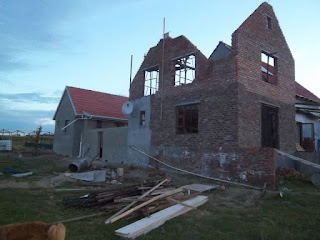Lynni doesn't appear to have a blog - Lynni, if I'm wrong please let me know. Thanks for hitting the followers button :)
Update: Lynni's blog can be found at: http://all--in--the--family.blogspot.com/
To quote from her profile info: she is: "a mum and foster mum to 12 now 13 great kids. We live in suburbia and try to live a 'greener' life. I make our bread,bake in a woodstove, cook from scratch, knit, crochet and sew, grow vegetables and some fruit, keep chickens, make soap and natural cleaning products. I have lot's of recipe books but never know what to have for dinner. I wish there were more hours in the day and I wish there were no fruit fly."
Lynni - huge admiration to you from me - where do you get the stamina to be mum to that number of children...!
Btw, I l-o-v-e your Esse Ironheart Woodstove :) Where did you find it?
----------------
Now that the gutters are up we have started harvesting our rain water.
RMan schlepped two 1000lt tanks with us from town. They had been used to store oil for a bakery, and, once empty, were just standing in the veld, doing nothing. A good clean out with vinegar, and vinegar and water, although messy, eventually did the job.
RMan and John, our local part-time labourer, sorted out the slab base for the tank(s). We needed to get the inlet fittings for the large 5000lt tank we purchased from our local co-op, so for the meantime we steered the water to the smaller 1000lt tank.
 |
| The gutter downpipe first got connected to the smaller tank |
Over 500lts of rain water was captured from 15mls of rain which fell only on one side of the garage roof.
 |
| Only 15mls of rain gave us over 500lts |
Bearing in mind that we only connected the one large tank to the downpipes late on Thursday and the other one at lunchtime on Saturday, after the 180mm of rain which fell from Wednesday to Sunday last week, we now have 2 X full 1000lt tanks, one 5000lt tank that is over 3/4 full and the other 5000lt tank has about 3000 lts. And we have an overflowing dam once again :)
We will need to purchase a further two 5000lt tanks - for the two other downpipes. And then we're planning on buying a further four 5000lt tanks, which we will place on the highest point of the property. As strange as it may seem, 2 X 500lt tanks are cheaper than 1 X 10 000lt tank!
That will eventually give us a total water storage of 42 000 ltrs (9 - 10 000 gal) of precious rain water. Could come in handy :)
As soon as the tanks at the base of the downpipes are full, the contents will be pumped up to the 4 X storage tanks. To pump the water it looks like RMan will be buying a petrol powered pump - and he has a choice of two. One has a 30mtr head pump, and will do an adequate job. The other is strong enough, and is designed, to pump water with hectic pressure in order to fight fires. Given our long, hot, windy summers that may better suit our purposes...
RMan says he's still deciding, but I know (him) better. He was originally talking about sorting out a solar powered pump, but, given the area's susceptibility to summer fires, I think that the more reliable source of moving the water (in case it's ever needed for fire fighting) may be the wiser option. Just in case it is ever required...



























